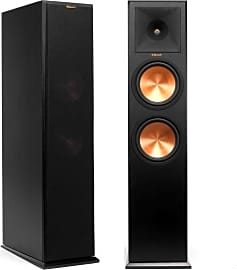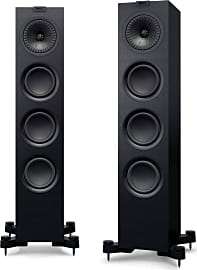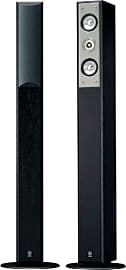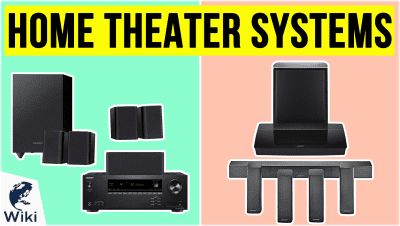The 10 Best Floorstanding Speakers

This wiki has been updated 41 times since it was first published in March of 2015. If you love big sound and have room for a tower of power in your living space, then one of these floorstanding speakers should become an integral component of your music system, home theater, or gaming center. Since you simply place these directly on the floor, no pesky installation or mounting is required, allowing you to immerse yourself in high-quality audio with minimal effort. When users buy our independently chosen editorial choices, we may earn commissions to help fund the Wiki.
Editor's Notes
December 10, 2020:
In our latest update, we added more high-end options to add variance to our list, as true audiophiles and home theater enthusiasts often favor floor standing models over smaller satellite and bookshelf speaker options.
Firstly, we replaced the KEF Q500 with the newer KEF Q550, which feature several updates to the popular previous-generation offering. These include new surrounds and rear suspension for their low-frequency drivers, completely remodeled crossovers that provide more accuracy in the bottom-end, and remodeled driver arrays to enhance the treble frequencies.
Next, we added the Wharfedale EVO 4.4, which are making waves from across the Atlantic for their exceptional quality and high-tech features, such as their Air Motion Transformer tweeters, which are usually found on far more expensive models, as well as Kevlar bass drivers, which provide excellent sound on a large scale.
The Dali Oberon 5 deserved a spot on our list, as they are a compact solution as compared to most similar-spec options, however they project sound across a wide spectrum with surprising clarity and detail. They are also among the more attractive models, with their two-tone contrasting face and sides.
Finally, we included the Focal Chora 826-D, which bring a little more international flavor to the ranking, as they are designed and manufactured in France. Equally effective for live music recordings and home theater use, their directional baffles surround you in 3D sound, with the ceiling-facing drivers effectively bouncing it around the room for a truly immersive sonic experience.
November 14, 2019:
Two items — the JBL Studio 280 and Fluance XL7F — were no longer available, so we took them off the list. We also noted that while the Klipsch R-24F has a refined look and produces a clean, natural sound, it lacks the ability to generate powerful bass. As a result, we downgraded this item a couple spots.
Conversely, we upgraded the Onkyo Reflexes, which is a nice value for a pair of energetic towers that can admirably handle sound from across the audio spectrum. They’re a bit large in size, but if you have the space, reports suggest they make a welcome addition to a home theater system.
The Klipsch RP-280F, one of our new additions, seems to satisfy seasoned audiophiles and casual music enthusiasts alike. Bass production as well as medium and high frequencies sound detailed and natural, which allows virtually any type of music to shine, from jazz or classical to guitar-heavy rock.
Special Honors
Axiom M80 This pair of award-winning towers is available in a variety of colors to suit different tastes and styles of décor. From deep, low bass to crisp midrange tones, your ears will be met with a pleasant blend of balance and clarity. Each individual speaker features six powerful drivers. axiomaudio.com
Advance Paris This line from Advance Paris is designed to provide a rich, balanced reproduction of both instruments and voices. The craftsmanship of the cabinets is evident — they’re made with high-quality components, and you won’t notice any vibrations disrupting the sound of your favorite song or movie. advance-acoustic.com
Elipson Speakers Elipson sprays to all fields, offering a vintage, ball-shaped model reminiscent of the 1950s and multiple towers that are equipped with cutting-edge modern technology. The cabinets are built for aesthetics as well as audio performance, and you can choose from several sizes depending on your needs. elipson.com
Floored By The Sound
The privacy issues alone are enough to have you burning down your tiny home and reverting to camping for the sense of space.
It was only a matter of time before people began to question the American aesthetic paradigm that directly correlates size with quality. In other words, "bigger is better" no longer holds sway over the land. Nowhere is this more evident than in those hallowed halls of IKEA, the hugely popular Swedish furniture outlet.
In their recent floor plans, IKEA has touted the improbable ergonomic wonder of squeezing a family of four into a 600-square-foot living space. Most Americans couldn't imagine occupying less than 500 square feet on their own, let alone with a spouse and two kids. The privacy issues alone are enough to have you burning down your tiny home and reverting to camping for the sense of space.
Whatever your living arrangement, the odds are that you value the space you have, and you want to make the most of it. If you also value your audio quality, you may find yourself at an impasse. One the one hand, you want to fill your room with delicious sounds, with the booming bass of a quality sub-woofer, with the chirping highs and clear, grounded mids of an array of bookshelf and satellite speakers. On the other hand, you don't have the space to shove all that hardware.
Fortunately, these floorstanding speakers make brilliant use of the most underutilized aspect of our homes: vertical space. Think about it; most of your furniture, from the bed and the couch, to the TV stands and tables, all cut off at about the waist, leaving you a ton of cubic feet to fill.
Floorstanding speakers take the depth of the sub-woofer, the punch of the more standard mid-range speakers, and the twinkling highs of the tweeters, and they stack them all up, one on top of the other. The woofer lives on the floor, where it can reverberate through the floor; the mains live in the middle, where they pump the most info through the room; and the tweeters live up top, popping out your highs as high as they can go, creating a totem pole of total audio.
Tiny Hands, Big Problems
I could never figure out why speakers came with grilles. On an aesthetic level, I always thought speakers looked better when you could see all of their workings, when the beautiful design of the silken domes was on full display. It also seemed silly to put anything between you and the audio reproduction that the speaker's engineers worked so hard to establish.
My friend had purchased a very nice sound system as a house-warming present to himself.
Then, I paid a visit to a friend with kids. I should note here that I don't have any children, so the following scenario never crossed my mind. My friend had purchased a very nice sound system as a house-warming present to himself. In addition to a few bookshelf speakers to create surround effects, the system had two lovely floorstanding speakers that lives on either side of his television.
I noticed that he kept his grille covers on the floorstanding speakers, but that he took them off of the bookshelf speakers, which were placed higher up in the room on ledges and bookshelves, so I asked him about it. Then, he removed the grill of the left floorstanding speaker and showed me where his curious little kid had punctured one of the speakers with his finger. He had left the covers off of the other speakers because his kid couldn't reach them.
There are plenty of variables to consider when purchasing floorstanding speakers. The number of included drivers is one important measure, and the fewer additional speakers you have set up in your space, the more you want built into your floorstanders. There's also size and color to take into account, to make sure that whichever speakers you end up with look comfortable wherever you place them. Whichever you do choose, make sure you keep those grill covers handy, even if you don't have kids around at the moment. I hear they can sneak up on you.
Needle Work
Audio amplification of any kind reaches way back to ancient Greece, where actors performing in amphitheaters wore masks that had little megaphones built into their mouths. These allowed the actors' voices to carry through the theater and all the way to the back row, thanks to the most rudimentary application of amplification.
You'll hear the music playing in the vibrations of the needle head.
It would be a very long time before that amplification design met with anything electronic, but the invention of the audio recording and its attendant phonograph started a revolution in human expression that continues to evolve (some might argue devolve) to this day. That was Thomas Edison, back in 1877, who wrapped metal cylinders in tinfoil and translated incoming sound onto grooves carved by a metal stylus. The same device could read those grooves and play back the vibrations.
Vinyl records work on much the same principal, and if you want to experience something a little crazy, disconnect a record player from any speaker system, put a record on and bring your ear up to the needle as it makes its way along the grooves. You'll hear the music playing in the vibrations of the needle head.
Of course, when you translate those vibrations into a voltage–and in the digital age, into zeroes and ones–you can send them through the wires wrapped beautifully around a speaker magnet and reproduce sounds with a clarity and accuracy that Edison himself may not have imagined.















